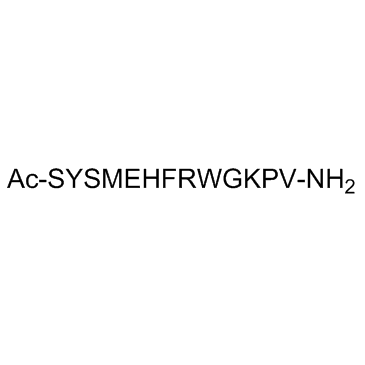α-MSH trifluoroacetate salt

α-MSH trifluoroacetate salt structure
|
Common Name | α-MSH trifluoroacetate salt | ||
|---|---|---|---|---|
| CAS Number | 581-05-5 | Molecular Weight | 1664.884 | |
| Density | 1.5±0.1 g/cm3 | Boiling Point | N/A | |
| Molecular Formula | C77H109N21O19S | Melting Point | N/A | |
| MSDS | Chinese USA | Flash Point | N/A | |
Use of α-MSH trifluoroacetate saltα-Melanocyte-Stimulating Hormone (MSH), amide stimulates melanocortin 1 receptor that results in the activation of adenylyl cyclase. |
| Name | α-Melanocyte stimulating hormone |
|---|---|
| Synonym | More Synonyms |
| Description | α-Melanocyte-Stimulating Hormone (MSH), amide stimulates melanocortin 1 receptor that results in the activation of adenylyl cyclase. |
|---|---|
| Related Catalog | |
| Target |
Melanocortin 1 receptor[1] Adenylyl cyclase[1] |
| In Vitro | α-Melanocyte-Stimulating Hormone (MSH), amide is an ancient tridecapeptide with potent inhibitory activity in all major forms of inflammation. α-Melanocyte-stimulating hormone (α-MSH) acts as an anti-inflammatory agent via down regulating the production and activity of the pro-inflammatory cytokines interleukin-1 (IL-1), tumor necrosis factor (TNF)-α and IL-6 expressed in various cells of the immune system. It also controls the nitric oxide production associated with inflammation. α−MSH inhibits nuclear factor-κB (NF-κB)-dependent gene transcription and NF-κB pathway induced by TNF and other inflammatory agents. This activity of α-MSH is mediated through the production of cyclic adenosine monophosphate (cAMP) and activation of protein kinase A (PKA) enzyme. α–MSH functions as a potent therapeutics for various conditions resulted through NF-κB activation including, inflammatory diseases, human immunodeficiency virus (HIV) replication in AIDS (acquired immunodeficiency syndrome), and septic shock[2]. |
| In Vivo | α-Melanocyte-Stimulating Hormone (MSH), amide (α-MSH) has an essential role to play in melanin production in animals. α-MSH regulates development of several skin diseases, including cutaneous inflammation and hyper-proliferative skin diseases[2]. |
| References |
| Density | 1.5±0.1 g/cm3 |
|---|---|
| Molecular Formula | C77H109N21O19S |
| Molecular Weight | 1664.884 |
| Exact Mass | 1663.792969 |
| PSA | 668.28000 |
| LogP | -1.77 |
| Index of Refraction | 1.682 |
| InChIKey | WHNFPRLDDSXQCL-QLUMQNPSSA-N |
| SMILES | CSCCC(NC(=O)C(CO)NC(=O)C(Cc1ccc(O)cc1)NC(=O)C(CO)NC(C)=O)C(=O)NC(CCC(=O)O)C(=O)NC(Cc1c[nH]cn1)C(=O)NC(Cc1ccccc1)C(=O)NC(CCCNC(=N)N)C(=O)NC(Cc1c[nH]c2ccccc12)C(=O)NCC(=O)NC(CCCCN)C(=O)N1CCCC1C(=O)NC(C(N)=O)C(C)C |
| Storage condition | 2-8°C |
| Water Solubility | Soluble in water (~1 mg/ml). |
|
Triterpene glycosides and other polar constituents of shea (Vitellaria paradoxa) kernels and their bioactivities.
Phytochemistry 108 , 157-70, (2014) The MeOH extract of defatted shea (Vitellaria paradoxa; Sapotaceae) kernels was investigated for its constituents, and fifteen oleanane-type triterpene acids and glycosides, two steroid glucosides, tw... |
|
|
Reduced melanocortin production causes sexual dysfunction in male mice with POMC neuronal insulin and leptin insensitivity.
Endocrinology 156(4) , 1372-85, (2015) Proopiomelanocortin (POMC)-derived peptides like α-melanocyte-stimulating hormone (MSH) substantially improve hepatic insulin sensitivity and regulate energy expenditure. Melanocortinergic agents are ... |
|
|
Effect of barodenervation on cardiovascular responses elicited from the hypothalamic arcuate nucleus of the rat.
PLoS ONE 7(12) , e53111, (2012) We have previously reported that chemical stimulation of the hypothalamic arcuate nucleus (ARCN) in the rat elicited increases as well as decreases in blood pressure (BP) and sympathetic nerve activit... |
| N-Acetyl-L-seryl-L-tyrosyl-L-seryl-L-methionyl-L-α-glutamyl-L-histidyl-L-phenylalanyl-L-arginyl-L-tryptophylglycyl-L-lysyl-L-prolyl-L-valinamide |
| α-Melanocyte Stimulating Hormone |
| MFCD00133062 |
| L-Valinamide, N-acetyl-L-seryl-L-tyrosyl-L-seryl-L-methionyl-L-α-glutamyl-L-histidyl-L-phenylalanyl-L-arginyl-L-tryptophylglycyl-L-lysyl-L-prolyl- |
| α-MSH |

